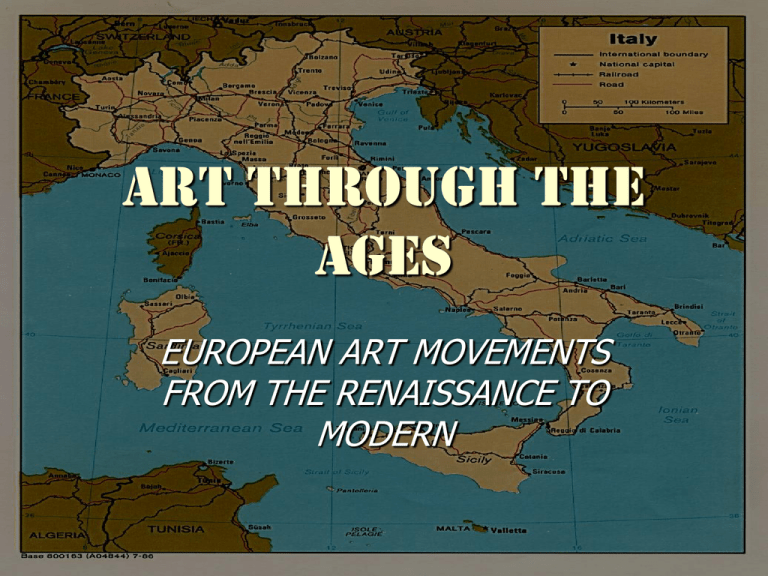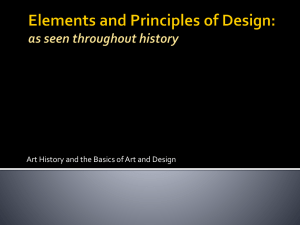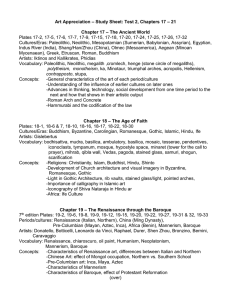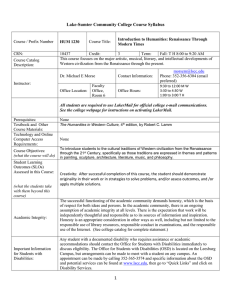art through the ages - Hinsdale Central High School
advertisement

ART THROUGH THE AGES EUROPEAN ART MOVEMENTS FROM THE RENAISSANCE TO MODERN ROMANESQUE & GOTHIC: THE PRELUDE TO THE RENAISSNACE ROMANESQUE ARCHITECTURE ► DURING THE 11TH AND 12TH CENTURIES MASTER BUILDERS REPLACED FLAT WOODEN ROOFS WITH LONG, ROUND STONE VAULTS KNOWN AS BARREL VAULTS GOTHIC ART ► ► GOTHIC CATHEDRALS WERE ONE OF THE GREATEST ARTISTIC TRIUMPHS OF THE HIGH MIDDLE AGES (10501300) CONSTRUCTION ON THE CATHEDRAL OF NOTREDAME IN PARIS STARTED IN 1163 AND ENDED IN 1300 INTERIOR OF A GOTHIC CATHEDRAL ART PRIOR TO RENAISSANCE FLAT , LACKING DEPTH & PERSPECTIVE ART PRIOR TO THE RENAISSANCE STIFF AND ARTIFICIAL THE RENAISSANCE GIOTTO PAVES THE WAY ► b. 1266, GIOTTO WAS CONSIDERED A FORERUNNER OF ITALIAN RENAISSANCE PAINTING ► A MORE REALISTIC APPROACH ► A DESIRE TO IMITATE NATURE ► HIS FIGURES WERE SOLID & ROUNDED ► 3- DIMENSIONAL, BUT APPROXIMATE ► RENAISSANCE & NATURE ► ► ► RENAISSANCE ARTISTS CONSIDERED THE IMITATION OF NATURE AS THEIR PRIMARY GOAL HUMANS WERE PLACED IN THE CENTER MASACCIO (1401-1428) PICKED UP WHERE GIOTTO LEFT OFF RENAISSANCE INTEREST IN ANTIQUITY ► RENAISSANCE ARTISTS HAD A KEEN INTEREST IN CLASSICAL ART, PHILOSOPHY AND VALUES ► BOTTICELLI’S PRIMAVERA IS CENTERED AROUND VENUS (THE GODDESS OF LOVE) RAPHAEL’S SCHOOL OF ATHENS 1511 DA VINCI’S LAST SUPPER DAVID: TWO VERSIONS DONATELLO MICHELANGELO SISTINE CHAPEL: A MASTERPIECE 1512 BRUNELLESCHI’S ARCHITECTURE DOME IN FLORENCE INTERIOR SAN LORENZO THE RENAISSANCE MOVES NORTH VAN EYCK NORTHERN RENAISSANCE FOCUS ON RELIGION DURER BRUEGHEL THE ELDER HIGH RENAISSANCE: MANNERISM MID-LATE 16TH CENTURY ► MANNERIST ART IS CHARACTERIZED BY A COMPLEX COMPOSITION, WITH MUSCULAR & ELONGATED FIGURES ► MICHELANGELO AND EL GRECO WERE TWO PROMINENT ARTISTS EL GRECO 1541-1614 17TH-CENTURY MOVEMENTS: THE DUTCH & BAROQUE REMBRANDT ► THE GOLDEN AGE OF DUTCH PAINTING WAS LED BY REMBRANDT & VERMEER DUTCH 17TH CENTURY: VERMEER BAROQUE ART: A CATHOLIC COUNTER CARAVAGGIO ► Baroque Art emerged around 1600, as an reaction against the intricate and formulaic Mannerist style which dominated the Late Renaissance. Baroque Art is less complex, more realistic and more emotionally affecting than Mannerism. BAROQUE ART CARRACCI’S ADORATION OF THE VIRGIN BERNINI: A BAROQUE MASTER ROCOCO KING LOUIS XV ► The Rococo style succeeded Baroque Art in Europe. It was centered in France, and is generally associated with the reign of King Louis XV (1715-1774). It is a light, elaborate and decorative style of art. ROCOCO: 18TH-CENTURY ELEGANCE WATTEAU WATTEAU TIEPOLO: A ROCOCO MASTER NEO-CLASSICAL ART: MID 18TH TO EARLY 19TH CENTURY ► Neoclassical is a severe, unemotional form of art harkening back to the style of ancient Greece and Rome. Its rigidity was a reaction to the Rococo style and the emotional Baroque style. Part of a general revival of classical thought, which was of some importance in the American and French revolutions. MENGS NEOCLASSICAL= NEW CLASSICAL OATH OF HORATII JACQUES-LOUIS DAVID DAVID- NAPOLEON’S FAVORITE ROMANTICISM: THE ANTICLASSICAL ► ► Late 18th Century to Mid 19th Century Romanticism might best be described as anti-Classicism. A reaction against Neoclassicism, it is a deeply-felt style which is individualistic, beautiful, exotic, and emotionally wrought. Although Romanticism and Neoclassicism were philosophically opposed, they were the dominant European styles for generations, and many artists were affected to a greater or lesser degree by both. Artists might work in both styles at different times or even mix the styles, creating an intellectually Romantic work using a Neoclassical visual style, for example. Great artists closely associated with Romanticism include J.M.W. Turner, Caspar David Friedrich, John Constable, and William Blake. CASPAR DAVID FRIEDRICH J.M.W. TURNER RAIN, STEAM, SPEED JOHN CONSTABLE ROMANTICS USED IMAGES OF NATURE IN THEIR WORK REALISM ► Mid-19th Century ► Realism is an approach to art in which subjects are portrayed in as straightforward manner as possible, without idealizing them and without following the rules of formal theory. COURBET’S STONEBREAKERS JEAN-FRANCOIS MILLET THE GLEANERS IMPRESSIONISM ► Influence of photography ► Interest in light, shadow ► Focus on everyday life—street scenes, still lives, parks, etc. ► Interest in how objects change in light over time CLAUDE MONET BERTHE MORISOT CAMILLE PISSARRO POST-IMPRESSIONISM ► ► ► Post-Impressionism France, 1880's to 1900 Post-Impressionism is an umbrella term used to describe a variety of artists who were influenced by Impressionism but took their art in different directions. There is no single well-defined style of Post-Impressionism, but in general it is less casual and more interested in formal structure and broad fields of color. CEZANNE PAUL GAUGUIN JOYOUSNESS VINCENT VAN GOGH Pointillism France, 1880's ► Pointillism is a form of painting in which the use of tiny primary-color dots is used to generate secondary colors. It is an offshoot of Impressionism, and is usually classified as a form of Post-Impressionism. Pointillism is focused on the specific style of brushwork used to apply the paint. GEORGES SEURAT Sunday Afternoon on the Island of Grand Jatte INTO 20TH-CENTURY EXPRESSIONISM ► Centered in Germany, C.1905 to 1940's ► Expressionism is a style of art in which the intention is not to reproduce a subject accurately, but instead to portray it in such a way as to express the inner state of the artist. KANDINSKY’S IM BLAU GEORGE GROSZ THE SCREAM: EDVARD MUNCH CUBISM ► ► Europe, 1908-1920 Cubism was developed between about 1908 and 1912 in a collaboration between Pablo Picasso and Georges Braque. Their influences were Tribal Art and the work of Paul Cezanne. The movement itself was not long-lived or widespread, but it began an immense creative explosion. Key concept of Cubism is that the essence of objects can only be captured by showing it from multiple points of view simultaneously. PICASSO SELF PORTRAIT PABLO PICASSO GUERNICA GEORGES BRAQUE The Glass of Absinthe Dada JEAN ARP ► ► Europe, 1916-1924 Dada was a protest by a group of European artists against World War I, bourgeois society, and the conservatism of traditional thought. Its followers used non sequiturs and absurdities to create artworks and performances which defied intellectual analysis MARCEL DUCHAMP THE FOUNTAIN 1917 DUCHAMP Futurism ► ► Italy, 1909-1914 Futurism is an Italian modernist movement celebrating the technological era. It was largely inspired by the development of Cubism. The core themes of Futurist thought and art were machines and motion. UMBERTO BOCCIONI UMBERTO BOCCIONI CARLO CARRA MANIFESTAZIONE INTERVENTISTA 1912 Surrealism ► Europe, 1924 to 1950's ► Surrealism is a style in which fantastic visual imagery from the subconscious mind is used with no intention of making the artwork logically comprehensible. Founded by Andre Breton in 1924, it was a primarily European movement which attracted many members of the chaotic Dada movement. It was deeply influenced by the psychoanalytic work of Freud and Jung. RENE MAGRITTE SALVADOR DALI The Persistence of Memory Abstract Expressionism ► ► Centered in New York City, 1946 to 1960's Abstract Expressionism is a form of art in which the artist expresses himself purely through the use of form and color. It is form of non-representational, or non-objective, art, which means that there are no concrete objects represented. Now considered to be the first American artistic movement of worldwide importance, the term was originally used to describe the work of Arshile Gorky, Willem de Kooning, and Jackson Pollock. ARSHILE GORKY How My Mother's Embroidered Apron Unfolds in My Life WILLEM DE KOONING WOMEN ON A BICYCLE 1952 POLLOCK NUMBER 22 POSTMODERN ART ► The remaining slides are widely considered to be Postmodern. Started after WWII (many feel it began in the 1960s) this movement reflects a tendency in art, thought and culture, to distrust objectivity, authority, universality, and moral and ideological absolutes. Postmodern artists tend to mix styles, cultures, techniques, and high and low forms. Often ironic or critical. Pop Art ► 1950's to 1960's ► Pop Art is a style of art which explores the everyday imagery which is part of contemporary consumer culture. Common sources include advertisements, consumer product packaging, celebrities, and comic strips. Leading Pop artists include Robert Rauschenberg, Andy Warhol, Roy Lichtenstein, and Jaspar Johns. ANDY WARHOL M A R I L Y N WARHOL ROY LICHTENSTEIN LICHTENSTEIN JASPAR JOHNS OPTICAL ART ► ► 1950's to 1960's Optical Art is a mathematically-oriented form of (usually) Abstract art, which uses repetition of simple forms and colors to create vibrating effects, moiré patterns, an exaggerated sense of depth, foregroundbackground confusion, and other visual effects. BRIDGET RILEY M.C. ESCHER MORE ESCHER: BECAUSE ITS COOL PHOTOREALISM 1960's to 1970's ► Photorealism is a movement which began in the late 1960's, in which scenes are painted in a style closely resembling photographs. The subject matter is usually mundane and without particular interest; the true subject of a photorealist work is the way we unconsciously interpret photographs and paintings in order to create a mental image of the object represented. CHUCK CLOSE ROBERT ESTES MINIMALISM Emerged in the 1960's ► Minimalism is a style of art in which objects are stripped down to their elemental, geometric form, and presented in an impersonal manner. It is an Abstract form of art which developed as a reaction against the subjective elements of Abstract Expressionism. FRANK STELLA ELLSWORTH KELLY Guggenheim—Bilbao Guggenheim—F.L. Wright Essay Practice Compare the ways in which the two works of art reproduced below express the artistic, philosophical, and cultural values of their times. Michelangelo, David, 1504 Giacametti, Man Pointing, 1947







